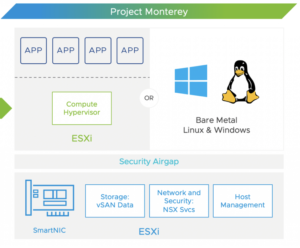VMware, Server Partners, Rework Hybrid Clouds Around Net Adapters

via Shutterstock
The shift to hardware accelerators used to boost the performance of AI, machine learning and cloud-native applications is also having the unintended consequence of adding complexity for already overworked development teams.
In response, a group of vendors led by VMware has launched an initiative to reboot hybrid cloud architectures to confront the partitioning of DevOps teams while preserving application performance. Project Monterey extends VMware’s Cloud Foundation software stack to support SmartNIC technology.
VMware and server partners Dell Technologies, Hewlett Packard Enterprise (HPE) and Lenovo said they would use smart network interface cards from Intel Corp., Nvidia and startup Pensando Systems. Network adapters would augment graphics processors, FPGAs and other hardware accelerators used to boost the performance of applications. Those apps are consuming increasing amounts of server CPU, the partners announced during VMware's VMworld 2020 virtual event on Tuesday (Sept. 29).
Network interface cards and other hardware accelerators are used to support increasing performance and security requirements. They also add complexity. Hence, VMware said it Cloud Foundation platform—consisting of vSphere, vSAN and the NSX network virtualization platform—will support SmartNIC technology.
The combination represents “a new architecture component that offloads processing tasks that the server CPU would normally handle,” the company said. The hybrid cloud architecture maintains computing virtualization on the server CPU while offloading networking and storage I/O to a SmartNIC central processor.
The result, according to the project partners, will be optimum use of available network bandwidth while preserving server CPU cycles to boost application performance. VMware said it has implemented SmartNICs on its ESXi bare-metal hypervisor used to partition servers into multiple virtual machines.
Beyond that implementation, the partners said Project Monterey remains a “technology preview.” Hence, no availability for the hybrid cloud framework was announced.
What was announced were plans by the infrastructure partners to develop “integrated systems” based on Project Monterey that will leverage SmartNIC technology from Intel, Nvidia and Pensando Systems.
San Jose-based Pensando emerged from stealth mode in October 2019 with a platform used to upgrade legacy architectures to a software-defined cloud. HPE is an early investor.
VMware (NYSE: VMW) signaled its shift to the Kubernetes cluster orchestrator last year with the launch of an initiative dubbed Project Pacific intended to upgrade its flagship vSphere server virtualization software using Kubernetes as its control plane.
The virtualization leader said Project Monterey is a continuation of that effort, this time focused on hardware architecture, reworking VMware Cloud Foundation to support enterprise applications forged during Project Pacific. Along with SmartNICs, VMware said the hardware effort extends Cloud Foundation to bare-metal operating systems and the applications they support.
Project Monterey “enables us to rethink cluster architecture and to make clusters more dynamic, more API-driven and more optimized to application needs,” VMware noted in a blog post. The framework exposes hardware accelerators to all the hosts in a cluster, “allowing all apps in the cluster to take advantage of those accelerators,” the company added.
Related
George Leopold has written about science and technology for more than 30 years, focusing on electronics and aerospace technology. He previously served as executive editor of Electronic Engineering Times. Leopold is the author of "Calculated Risk: The Supersonic Life and Times of Gus Grissom" (Purdue University Press, 2016).











